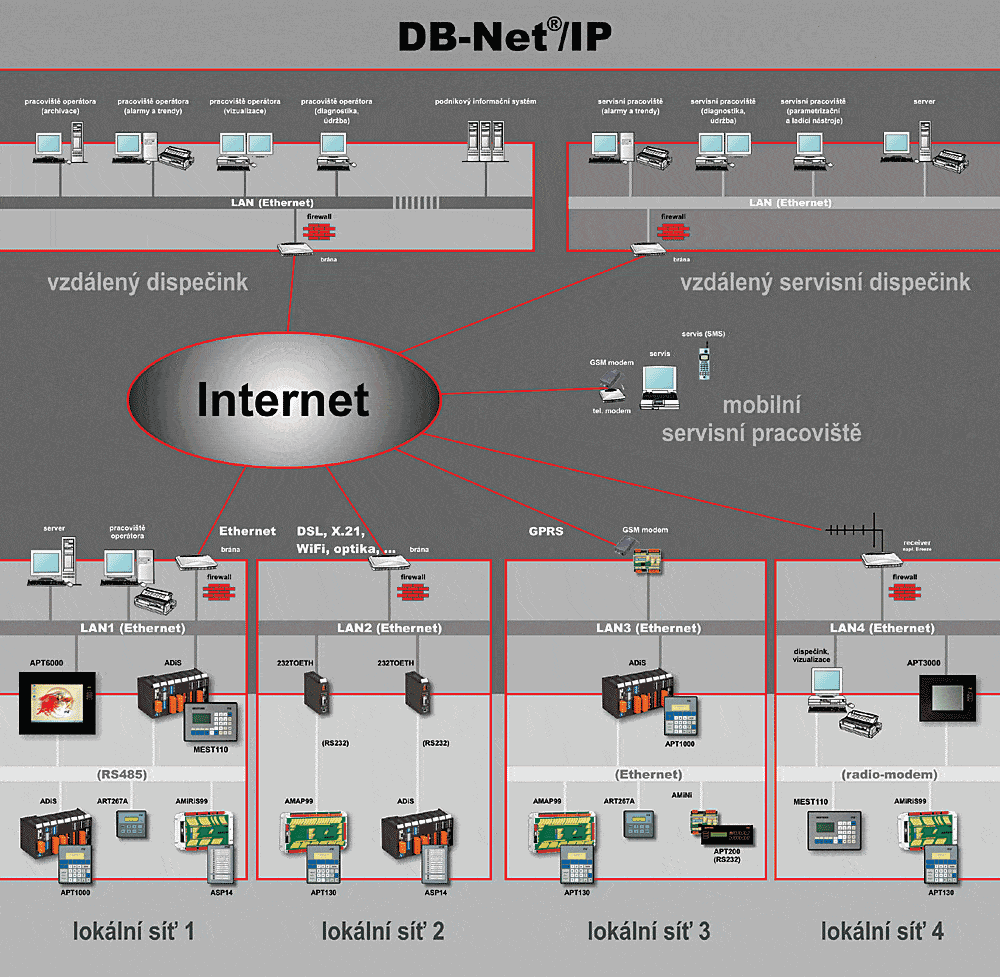DB-Net/IP – Industrial information system
DB-Net/IP is a set of hardware and software resources for incorporating control systems directly into intranet networks. Such networks are generally called “Industrial Ethernet” and use the TCP/IP family of communication protocols. The DB-Net/IP system is based on proven technologies which are broadly available on the Internet and concentrates on providing additional specific industrial-automation attributes such as data transfer reliability, robustness and reliable maintenance and supervision possibilities.
The basic part of the system is the control system (a programmable logic controller, PLC) with its own intelligence that ensures local control of technological system and secures defined functioning of the controlled unit even in situations of communication failure with other control systems or superior computer. All AMiT control systems and programmable controllers can be connected to a DB-Net/IP system, communication is ensured by a multimaster-multislave RS485 or industrial Ethernet-based protocol.
The major advantage of the AMiT control systems software are so called local archives enabling filing of recorded and computed data even during control centre closure or communication breakdown. Automatic history data transmission protects users against loss of important data even in emergency situations.
The DB-Net/IP information system provides comprehensive support for building control centres and data transmission to higher-level information systems. A number of drivers is available for connecting the system communication to visualisation and information resources.
DB-Net/IP basic components
Program function modules
Special function modules in DetStudio take care of data transmission over industrial Ethernet. The modules define the Ethernet remote stations (of the control system), define static routing, detect the remote stations status and ensure database variables transmission over Ethernet.
Communication drivers for control centres
The drivers ensure data transmissions from/to control systems on PCs or on server stations using the UDP protocol. The drivers can use both some AMiT applications (the DetStudio development environment, the ViewDet service software) as well as third-party applications (visualisation systems, special archiving and program applications, SQL servers of parent ERP implementations, etc.).
Ethernet communication lines in control systems
Most of the AMiT control systems have a 10-Mbps or 100-Mbps Ethernet interface included. The Ethernet-enabled control systems can act as a gateway and route Ethernet communication into a native communication network on RS232/485 lines. This design links the RS485 segments to the Ethernet network.
Key advantages and specific features
Authentication
The DB-Net/IP system’s security features check the access authorisation. Each communication packet is secured by authentication data. The password is not transferred over the network, so it cannot be tapped.
Encryption protection
Primary protection is ensured since the data cannot be tapped as they are transmitted encrypted. The TCP/IP protocol family allows adding more security using a wide range of third-party security applications (virtual private networks, encrypted tunnels, SSH-tunnels…).
Control system applications download, remote maintenance
Any location of the DB-Net/IP information system is suitable for uploading applications into the control systems, monitoring process data, debugging using all the tools of the DetStudio parameterisation software and using the ViewDet service program. All of these tasks can be done remotely, through the public Internet.
Station status data
All control systems and parent computers can use the DB-Net/IP system to determine the status of any other station and change its activity accordingly.
Direct connectivity of control systems
There is no need for any intermediate device (most frequently PC-based) for data transfer from a proprietary industrial communication into Ethernet. No other device needs to be defined (parameterised).
Communication drivers
Communication drivers in the form of ActiveX elements and libraries for Windows and Linux support creating and implementing parent information systems’ applications. The drivers are distributed at no charge.
